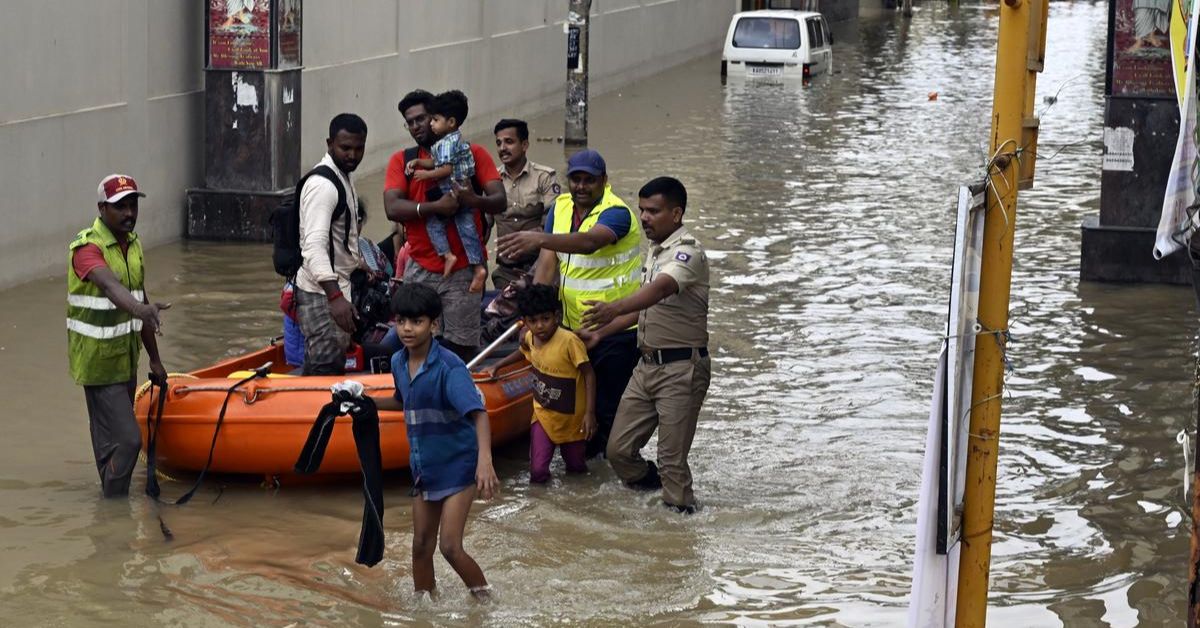(Featured image courtesy The Hindu and The Hindustan Times)
On Sunday, Bengaluru was battered by intense rains that left large parts of the city waterlogged, disrupting daily life and claiming three lives, including a minor. From traffic snarls to flooded homes and power outages, the downpour brought the happening IT hub to a grinding halt once again.
The India Meteorological Department (IMD) issued a yellow alert for the city, warning of continued rainfall till Thursday. Across Karnataka, 23 districts, including Bengaluru, are on high alert, with many still reeling from the sudden water surge.
This isn’t the first time the city has faced such a crisis, but each year, the impact seems to deepen. What’s worse is that the monsoon hasn’t even set in officially.
Yet, there is hope.
Urban planner and water expert S Vishwanath, popularly known as ‘Zenrainman’, believes that Bengaluru can emerge stronger — but only if we learn from these incidents and take action. He lays down six key steps that can help prevent this cycle of urban flooding from repeating, not just in Bengaluru but across Indian cities.
1. Audit the roads, not just build them
A city’s roads are not merely meant for vehicles, they’re also part of its stormwater drainage system. Vishwanath calls for a comprehensive road audit to assess whether roads have proper stormwater drains on either side. More importantly, these drains must be interconnected and designed to carry water towards natural bodies like rivers or lakes.
Currently, many stormwater drains end abruptly, creating choke points. Cross drainage works, like culverts and pipes, must be in place so that water can flow seamlessly from one side to another. This audit, he says, should cover every road in the city.
2. Protect stormwater channels from encroachment
Stormwater channels need clear demarcation and protection. Lining them with concrete can help define their boundaries, ensuring that future construction doesn’t eat into their space. If the government can acquire land for metro stations and roads, why not for stormwater drains?

According to Vishwanath, a systematic, watershed-based hydrological design is needed. Instead of building drains in a piecemeal manner, authorities must map how water flows across the city and plan accordingly. Compensate landowners fairly, but build a robust drainage system for the future.
3. Expand the sewage network
One of the key contributors to urban flooding is the mixing of sewage with rainwater, which not only blocks drains but also poses serious health risks. Bengaluru must invest in a city-wide sewage network to ensure that wastewater is treated and not dumped into storm drains.
“Flood waters should not carry sewage,” he warns. By saturating the city with sewage pipelines connected to treatment plants, we reduce both pollution and blockage.
4. Sharpen our weather predictions
Bengaluru has 99 automatic weather stations, the highest density in any Indian city. While these are good at tracking current weather conditions, Vishwanath suggests they must evolve further.
He recommends enhancing the system’s predictive ability to forecast rain at least three days in advance. With better modelling, technological advancements, and communication, early warnings can be issued to areas most at risk, allowing for preventive steps and timely alerts.
5. Citizens, too, can be part of the solution
It’s not just up to the government. Vishwanath urges apartment complexes and individual homeowners to adopt rainwater harvesting in earnest. Bengaluru already has a by-law in place: 60 litres per square metre of roof area and 30 litres per square metre of paved area must be harvested or recharged.
If followed sincerely, this could reduce flood impact by up to three times. Imagine if every house or building collected its rainwater and allowed it to seep into the ground — it would not only ease flooding but also recharge the city’s aquifers.
6. Think in watersheds, not wards
Finally, Vishwanath stresses a shift in planning: from administrative zones to natural watersheds. Each lake must be treated as part of a larger hydrological unit. Water should be allowed to flow naturally from one lake to another, with sluice gates ready to manage overflow during heavy rain.
This means that before a major rainfall event, authorities can release water in a controlled manner, creating space in lakes to absorb the incoming deluge. Instead of panic, there can be preparedness.
Flooding isn’t just a result of heavy rainfall, it’s often the symptom of poor urban planning. But the solutions are within reach. It’s time we stopped blaming the rain and started preparing for it. Because with the right steps, the next downpour need not mean disaster. It could instead be a test we pass with flying colours.
Edited by Vidya Gowri Venkatesh.

No comments:
Post a Comment